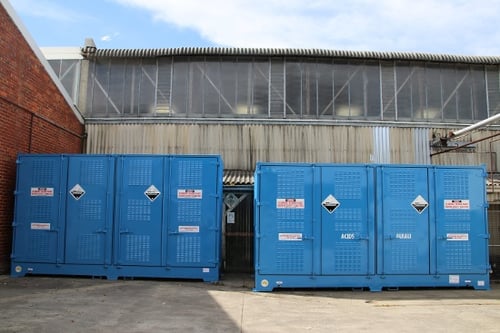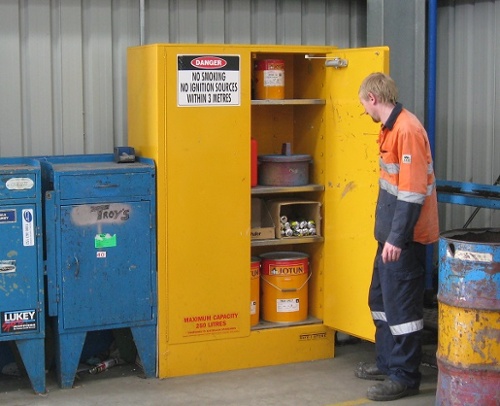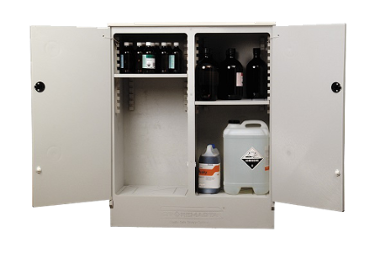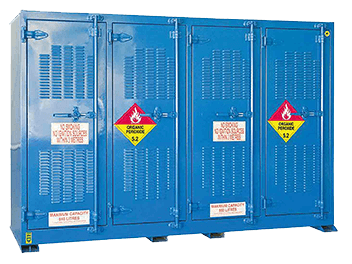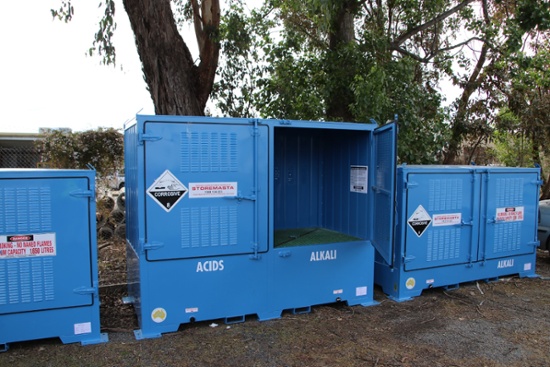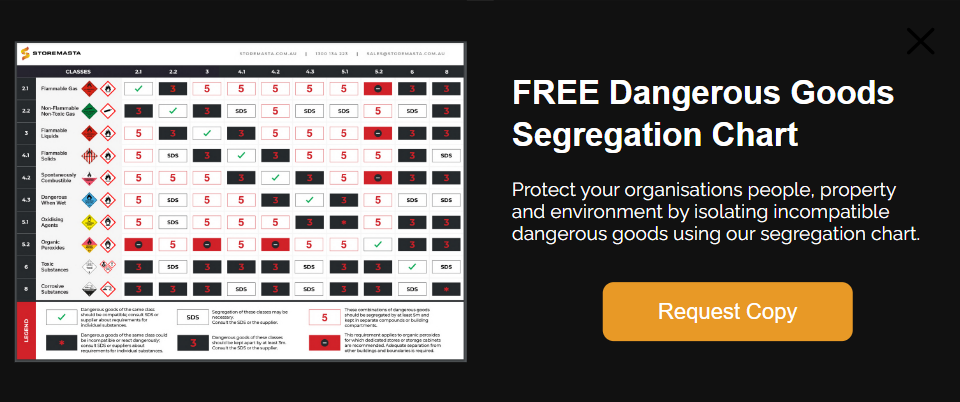Do you use corrosive substances, such as hydrochloric acid and sodium hydroxide, in your operations? As dangerous substances that can destroy living tissue, property and the natural environment, it’s important to mitigate risk in your chemical stores.
One significant factor that must be considered when storing Class 8 Corrosive Substances is ensuring that they are kept well away from other incompatible classes of dangerous goods. Of the eight other classes of dangerous goods, there are many that react dangerously with corrosive substances and others that are simply incompatible.
IMPORTANT RESOURCE: The Australian Standard that outlines the requirements for storing and handling mixed classes of dangerous goods is AS NZS 3833.
What are Incompatible Substances and Those That React Dangerously?
When it comes to the safety of your dangerous goods store, chemical segregation is a key topic. But before you determine the segregation requirements, it’s a good idea to understand how these chemicals can interact with each other to fully understand the proper risk controls.
The Australian Standard provides the definitions for:
- Substances that are incompatible
- Those that react dangerously
Defining Incompatible Substances
Incompatible substances are those substances that are:
- Likely to increase the risk to people, property and the environment when mixed or brought into contact with another substance.
- Listed in the Australian Dangerous Goods Code or NZS 5433 as being incompatible.
- Declared by the local regulatory authority as being incompatible
Defining Substances that React Dangerously
Substances that will react dangerously are those substances that react in a manner that directly creates a hazard due to the reaction:
- Producing an explosion
- Being violent
- Producing a potentially explosive combination of products
- Producing toxic vapours or gases; or
- Producing fire or rapid evolution of heat
Dangerous Goods Segregation
Dangerous goods that are incompatible or will react dangerously with Class 8 Corrosive Substances must be segregated during storage to avoid violent chemical reactions.
These incompatible classes of dangerous goods can be safely segregated by storing them in separate chemical storage cabinets or outdoor dangerous goods stores.
Storing Class 8 Corrosive Substances and other incompatible substances in the same dangerous goods store must be always avoided.
If you are planning on using the same dangerous goods store for mixed classes of dangerous goods, the substances must be segregated by certain distances. The required distances for segregating incompatible classes of dangerous goods are outlined in the Australian Standard AS NZS 3833 - The storage and handling of mixed classes of dangerous goods in packages and intermediate bulk containers.
We’ll now discuss the compatibility of corrosive substances with other classes of dangerous goods.
Class 2.1 - Flammable Gas / Class 2.1 Non-Flammable Non-Toxic Gas
Flammable and non-flammable gases are incompatible with corrosive substances.
These substances cannot be kept together during storage. If these substances must be stored in the same dangerous goods store, they must be kept apart by at least 3 metres, with separate spill bund systems.
Another risk that exists when storing dangerous gases and corrosive substances together is the risk of the corrosive substances corroding the gas cylinder. If the gas cylinder corrodes it could burst and become a flying projectile that could harm people and property.
Class 3 - Flammable Liquids
Flammable and combustible liquids are incompatible with Class 8 corrosive substances.
Flammable and combustible liquids must not be stored with any corrosive substances unless they are properly segregated, with separate chemical bunding.
If you must store flammable liquids and corrosives in a common dangerous goods store, the flammable liquids and corrosive substances must be segregated by a distance of at least 3 metres. You must also ensure that no leaks or spills come into contact, so separate bunds are essential.
We recommend Class 3 Flammable Liquids cabinets for dedicated indoor storage of your flammable liquids.
Can you Store Flammable and Corrosive Together
As we’ve highlighted in this blog, Class 3 Flammable Liquids are incompatible with Class 8 Corrosive Substances. Therefore, you can not store flammable liquids and corrosive chemicals in the same store without applying the rules of dangerous goods segregation.
Alternatively, you can choose a compliant Class 3 cabinet for storage of your flammable liquids, and a Class 8 cabinet for dedicated storage of corrosive substances.
What is the Difference between a Corrosive and Flammable Cabinet?
The key difference between a corrosive substance storage cabinet and a flammable liquids cabinet is that corrosive cabinets must be chemically resistant to the Class 8 chemicals. Therefore, leaks and spills in a corrosive cabinet will be directed into a spill sump that is constructed in a material that prevents corrosion of the equipment.
Storemasta’s range of corrosive cabinets offers storage solutions for all types of corrosives. Our range are constructed from metal or polyethylene materials, with the type of cabinet that you select dependent on the pH level (corrosive level) of your chemicals.
Poly cabinets provide corrosion protection from chemicals that emit harsh corrosive vapours, as well as present a corrosive spill risk. On the other hand, metal corrosive cabinets are fitted with PVC spill trays to prevent the metal storage equipment from being corroded in the event of leaks and spills.
Highly corrosive chemicals will be stored in the polyethylene cabinet, while less corrosive chemicals will suit the metal cabinet.
Poly cabinets are suitable for highly corrosive chemicals which can cause corrosion due to the emission of vapours.
Class 4.1 - Flammable Solids
Flammable solids and corrosive substances may or may not be incompatible – depending on the type of substance that you’re planning to store.
To ensure that these substances don’t pose any further risk upon your workers, it’s important to check the compatibility of the two substances before storing them together.
The compatibility of the substances can be determined by checking the safety data sheets for both substances. It is also good to speak to the supplier or manufacturer of the hazardous substances to get their advice on the segregation and storage for that particular substance.
Class 4.2 - Substances Liable To Spontaneous Combustion
Spontaneously combustible substances and corrosive substances are incompatible classes of dangerous goods.
To avoid any further harm to the people of your organisation, its best to store these substances in separate indoor chemical storage cabinets. If spontaneously combustibles and corrosive substances have to be stored in the same dangerous goods store, they must be kept apart by at least 3 metres, with separate spill bunding.
Class 4.3 - Dangerous When Wet
Dangerous when wet substances emit flammable gases when in they come contact with water. These Class 4.3 dangerous goods may or may not be incompatible with corrosive substances.
Just like flammable solids, you must determine the compatibility of Class 4.2 and Class 8 dangerous goods by checking the safety data sheets for each substance. It is also good to seek advice from the supplier or manufacturer of the hazardous substance.
Find out more about chemical segregation
Class 5.1 - Oxidising Agents
Oxidising agents and corrosive substances are incompatible.
These classes of dangerous goods must not be kept together. If these substances are stored in the same dangerous goods store, they must be segregated by at least 3 metres with separate bunds to avoid these substances coming into contact.
When corrosive substances and oxidising agents mix, they can produce dangerous by-products that are harmful to human health. An example is when potassium permanganate and hydrochloric acid react.
These two substances will release chlorine gas. If you breathe chlorine gas it will mix with the water in your lungs and produce acids which will dissolve your lungs and stop you from breathing. Inhaling chlorine gas can result in death.
REMEMBER: If you’re storing mixed classes of chemicals indoors, Class 5.1 storage cabinets are a suitable segregation method for your oxidising agents. Alternatively, follow the rules of chemical segregation and separate by at least 3 metres from corrosive substances.
Class 5.2 - Organic Peroxides
Organic peroxides and corrosive substances are also incompatible.
You must never store Class 5.2 substances and Class 8 substances together. If organic peroxides and corrosive substances have to be stored in a similar store, they must be segregated by at least 3 metres, with separate spill bunds, to reduce risk.
Organic peroxides must be segregated from incompatible substances, including corrosive chemicals.
Class 6 - Toxic Substances
Just like class 4.1 and class 4.3 dangerous goods, toxic substances may or may not be incompatible with corrosive substances. Before storing toxic and corrosive substances together check the compatibility of each substance by consulting their safety data sheets.
Class 8 - Corrosive Substances
Even though they are of the same dangerous goods class, some types of corrosive substances are compatible — and some will react dangerously.
Before storing two different corrosive substances together, it’s vital that you determine their compatibility by consulting the safety data sheet for each substance.
For example, if you mix a strong base such as sodium hypochlorite with a strong acid such as hydrochloric acid, it will result in a violent chemical reaction. The reaction will produce excessive amounts of heat and chlorine gas. The rapid evolvement of chlorine gas causes the corrosive substances to splatter and boil putting people in the nearby area at risk. Chlorine gas is also very toxic and harmful to human health.
Some Class 8 chemicals may be incompatible, so segregation of different corrosives may be required.
Class 8 Compatibility
Thanks for taking the time to read our post about the compatibility of corrosive substances with other dangerous goods classes, such as flammable liquids, organic peroxides and toxic substances.
As corrosive substances will react dangerously with a number of other dangerous substances, it’s very important that you apply the rules of segregation when you are storing corrosive substances with other classes of dangerous goods. If you’d like a dangerous goods segregation chart to help identify which classes of dangerous goods require segregation, go ahead and download our free chart by simply clicking the link. This resource will help you apply the rules of chemical segregation to your dangerous goods stores.
Joining the team as a Dangerous Goods Storage Consultant, Melissa Hampton became Storemasta's Marketing Manager in late 2021. With extensive knowledge and experience in chemical compliance, Melissa is responsible for leading the Marketing team and helping shape their marketing strategy. In her spare time, you can find Melissa hiking, swimming and enjoying the great outdoors in beautiful north-west Tasmania.
